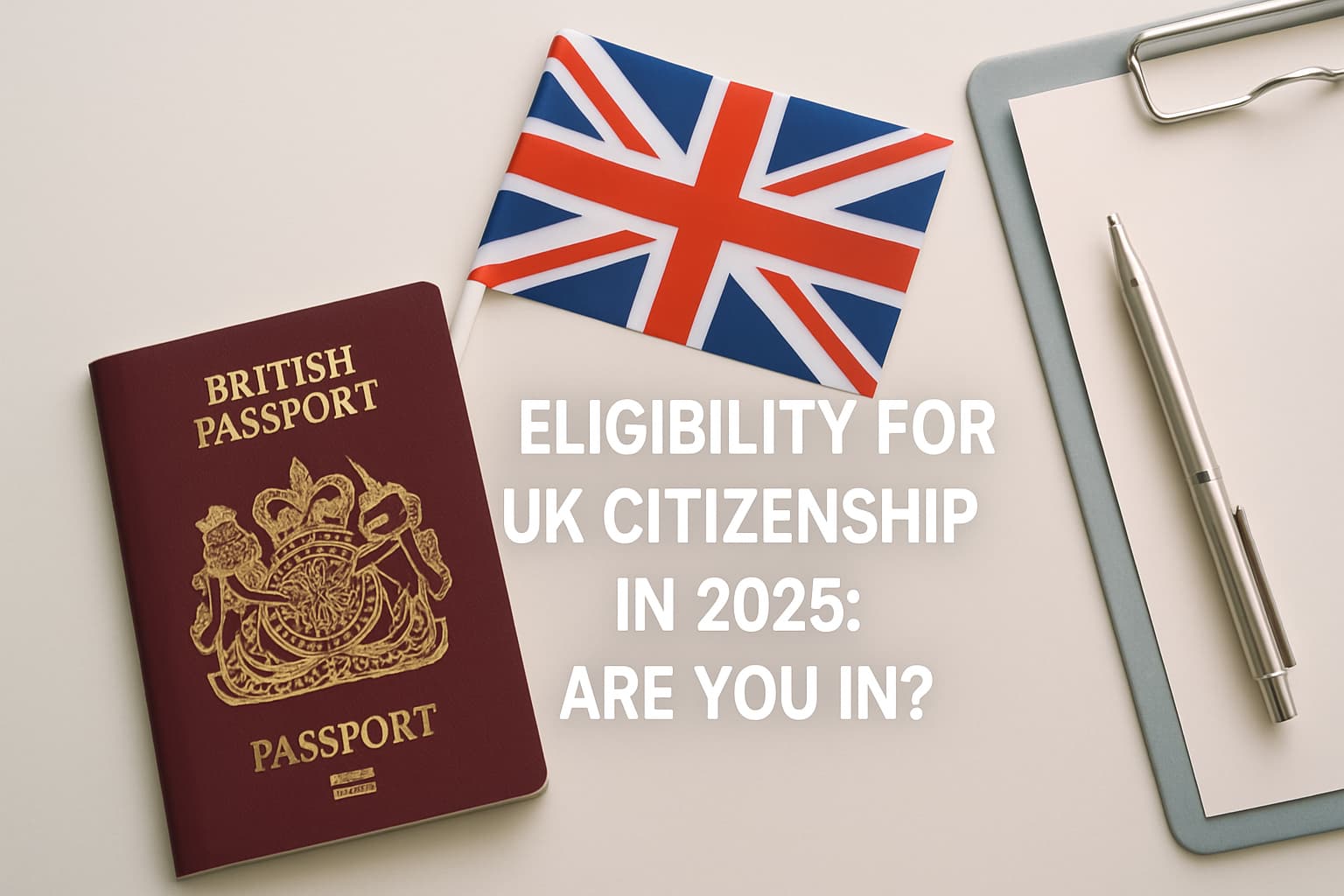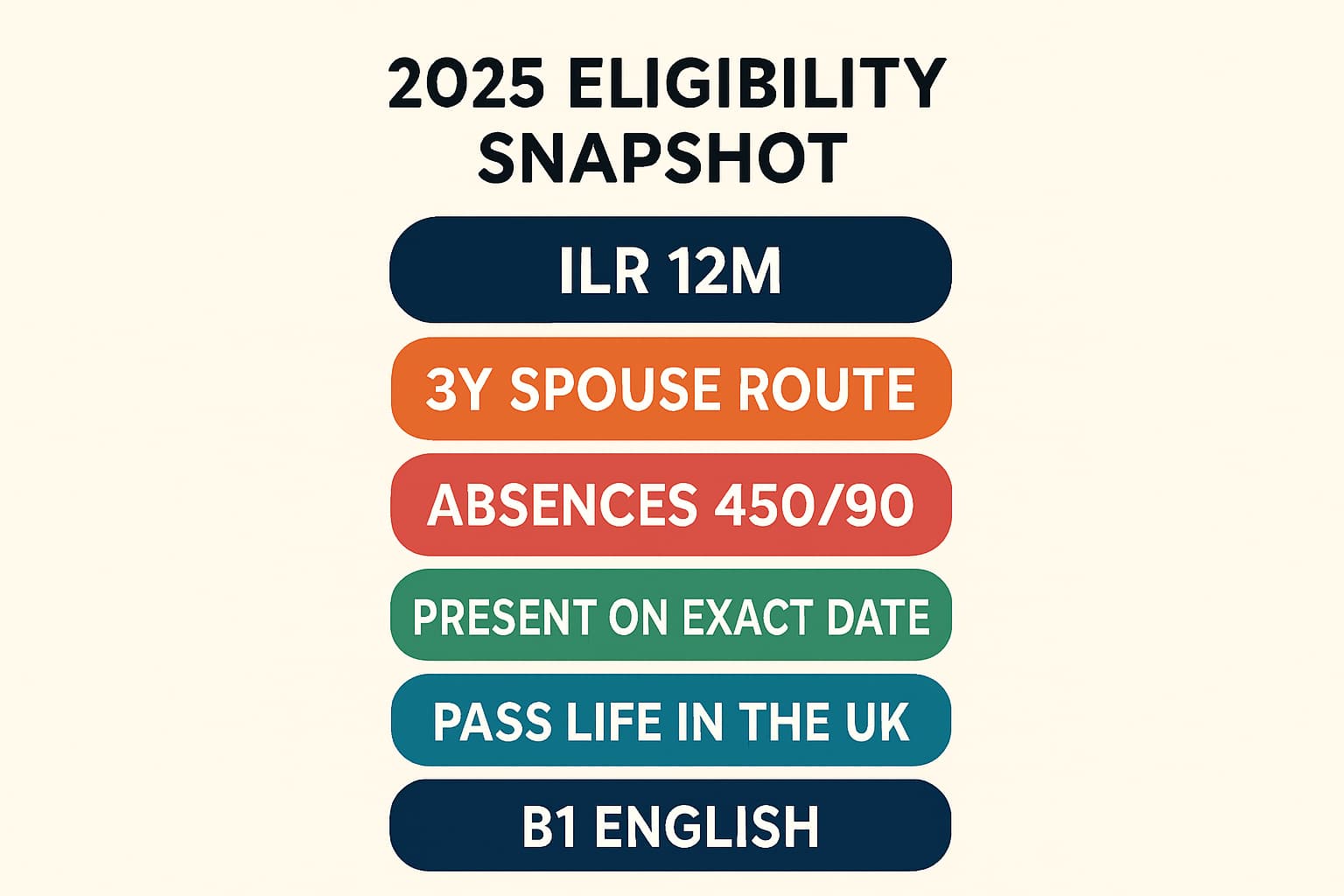Eligibility for UK Citizenship in 2025: Are You In?

Wondering if you meet the eligibility for UK citizenship in 2025? Use this step-by-step guide to check where you stand—fast—and map your route to approval.
We cover qualifying paths, exact rules on residence and absences, good character, English and the Life in the UK Test, plus evidence and timelines. You’ll also get an app‑based study plan to pass the test first time.
Start Here: Your 2025 eligibility snapshot
Quickly gauge if you’re on track. If most answers are “yes,” you’re likely ready to apply; if not, see what to fix.
Have ILR, EU settled status, or indefinite leave to enter—and (for most) held it for 12 months?
Met the lawful residence period: 5 years (most) or 3 years if married to a British citizen?
Absences within limits: generally no more than 450 days in 5 years (or 270 in 3 years) and no more than 90 in the last 12 months?
Physically present in the UK on the exact date 5 (or 3) years before your application reaches the Home Office?
Passed the Life in the UK Test and satisfied the English language requirement?
Good character: no serious criminality, tax issues, or immigration breaches?
Check the official Home Office overview and the detailed Guide AN (Oct 2025) for the latest criteria.

Who can apply for citizenship? (paths that qualify)
There are two main naturalisation routes—plus registration options in special cases. Pick the route that fits your history.
Route | Qualifying residence | ILR/Settled timing | Absence limits |
|---|---|---|---|
Section 6(1) (standard) | 5 years | Held ILR/settled for 12 months | ≤450 days in 5 years, ≤90 in last 12 months |
Section 6(2) (spouse/civil partner) | 3 years | ILR/settled on application date (no 12‑month wait) | Typically ≤270 days in 3 years, ≤90 in last 12 months |
Naturalisation: 5-year route (most applicants)
This is the standard route under Section 6(1). You usually need 5 years’ lawful residence, ILR or EU settled status held for 12 months, and to meet absence, good character, English, and Life in the UK requirements. See the Home Office criteria.
Spouse/civil partner of a British citizen: 3-year route
Under Section 6(2), you must have lived in the UK for 3 years and hold ILR/settled on the day you apply—no need to wait 12 months. Full details are on gov.uk.
Registration and special cases (children and others)
Registration is different from naturalisation and may apply if:
Your child is eligible to register as British (born in the UK to settled parent later, or other provisions).
You’re stateless, a British Overseas Territories citizen/Windrush case, or fall under specific discretionary categories.
Because registration routes vary, review the relevant Home Office guidance or seek legal advice where needed.
Core eligibility requirements explained
Immigration status: ILR or EU settled status
Definition: You must be free from immigration time restrictions—holding Indefinite Leave to Remain (ILR), EU settled status, or indefinite leave to enter. Most applicants must hold this for at least 12 months before applying; spouses can apply as soon as they have ILR/settled. See the official rules.
Does pre‑settled count? No. Pre‑settled alone is not sufficient for naturalisation. Upgrade to settled status first under the EU Settlement Scheme, then consider applying.
Need ILR first? Use our guide: Indefinite Leave to Remain: Your Step-by-Step Roadmap.
Residence and absence limits (5-year/3-year totals)
For the standard 5‑year route you should not have exceeded:
450 days outside the UK in the 5 years before application
90 days outside the UK in the last 12 months
Spouse/civil partner route usually allows up to 270 days in the 3‑year period and 90 days in the last 12 months. See the Home Office Guide AN (Oct 2025) and Citizens Advice overview.
Physical presence on the exact qualifying date
You must have been physically present in the UK exactly 5 (or 3) years before the date the Home Office receives your application. If not, wait until a date that meets this rule. See the official reminder in how to apply.
Example: If your application will be submitted on 20 June 2025, you must have been in the UK on 20 June 2020 (or 20 June 2022 on the spouse route).
Good character: criminality, taxes, immigration history
The Home Office checks criminal records, civil judgments, financial soundness (including tax compliance), and immigration history. Serious or recent offences, deception, and unpaid taxes can lead to refusal. Review thresholds in the Guide AN (Oct 2025).
English language requirement (approved tests and exemptions)
You must show knowledge of English, Welsh or Scottish Gaelic. Most applicants meet this via a B1 level Secure English Language Test (SELT) from an approved provider (for example, IELTS SELT or Trinity College London), or with a UK degree or a degree taught in English verified via ECCTIS. See the official guidance. If you still need a test, read: B1 English Test for ILR/Citizenship: Pick the Right Exam.
Life in the UK Test: what to expect and how to pass
The Life in the UK Test has 24 questions, 45 minutes, and a pass mark of 18/24. Bring valid ID, book via the official service, and arrive early. Focus on high‑yield chapters (history timelines, traditions, political system) and do repeated mocks. See: How to Prepare for the Life in the UK Test.
Get exam‑ready fast: Life in the UK Test App
If the test is the last thing blocking your eligibility, the Life in the UK Test App helps you pass first time with:
Complete official handbook content optimised for mobile micro‑learning
Smart learning assistant “Brit‑Bear” and a live readiness score
650+ questions with explanations, mock tests, and optional Hard Mode
Offline access so you can study anytime
Users report clearer focus and fewer retakes by tracking weak areas and drilling them with Hard Mode. Download now: App Store | Google Play.
Are you exempt from English or Life in the UK?
You may not need to meet one or both knowledge requirements if you are:
Age 65+ (automatic exemption for both)
Medically exempt due to a long‑term physical or mental condition—submit medical evidence from a clinician
Claiming an approved nationality/qualification exemption for English
See the official criteria in the Guide AN (Oct 2025). For details and examples, read: Life in the UK Test Exemptions: Full 2025 List.
Evidence you’ll need to prove eligibility
Status and identity
ILR/settled proof: BRP, eVisa share code, or Home Office letter/approval
Passport(s) covering the qualifying period
Proof of name changes (if any)
Residence, absences, and travel history
UK address evidence: council tax, tenancy, utility bills, bank statements
Employment/self‑employment: payslips, P60s, HMRC employment or SA records
Travel history: entry/exit stamps, boarding passes, employer letters for work travel
Good character and tax compliance
HMRC printouts confirming tax status and payments where relevant
Disclosure of cautions/convictions; overseas police certificates if requested
Bankruptcy/IVA documentation if applicable
English and Life in the UK Test proof
SELT B1 certificate or ECCTIS evaluation for degrees taught in English
Life in the UK Test pass notification letter/reference
Exemption evidence for age or medical reasons, where applicable
Edge cases and Home Office discretion
Excessive absences: when and how discretion applies
The Home Office can sometimes overlook modest excess absences for compelling reasons (e.g., essential work travel or serious family illness), especially if you meet all other criteria and have strong UK ties. Citizens Advice notes possible discretion up to 480 days in 5 years and 100 days in the last 12 months in limited cases—see their guidance and the Home Office Guide AN.
Fixed penalties and minor offences
Speeding fines and other fixed penalty notices are not normally treated like criminal convictions but must be declared. More serious or repeated conduct can affect the good character assessment. Always disclose accurately per the Guide AN.
Immigration breaches, overstays, and deception
Overstays, unlawful work, or deception can lead to refusal and may trigger cooling‑off periods. The standard test includes whether you were in breach of immigration laws during the qualifying period. See Home Office guidance.
Time on pre‑settled status and switching to settled
Pre‑settled time can count towards residence, but you cannot naturalise while only holding pre‑settled status. Secure settled status first, then apply (and wait 12 months unless on the spouse route). See gov.uk.
2025 updates and policy watch
Rules and guidance can change. Before applying, re‑check:
The current criteria on gov.uk
Detailed casework policy in the Guide AN (Oct 2025)
Your physical presence date calculation: How to apply
If you’re relying on a niche route (e.g., UK Ancestry to ILR, then citizenship), confirm your ILR path first on gov.uk ILR.
Pre‑application checklist and timeline
Use this at‑a‑glance plan to go from “maybe eligible” to “ready to submit.”
Confirm route: 5‑year standard or 3‑year spouse/civil partner.
Verify status: ILR/settled (and 12 months held unless on spouse route).
Calculate absences and ensure they’re within limits or gather discretion evidence.
Confirm physical presence on the exact qualifying date.
Pass the Life in the UK Test and meet English at B1 or claim an exemption.
Compile evidence for residence, identity, and good character (including HMRC).
Finish the online form, upload documents, and book biometrics.
Await a decision and prepare for the citizenship ceremony.
30‑day eligibility and documents plan
Week 1–2: check route, status, and absences; book test. Week 3: gather evidence and pass the test. Week 4: final reviews, declarations, and submit.
Day 1–3: Status and physical presence check; map absences
Day 4–7: Book Life in the UK; schedule English test if needed
Day 8–14: Intensive study and mocks; start document collection
Day 15–21: Finalise evidence; HMRC printouts; employer letters
Day 22–28: Application form, uploads, and quality check
Day 29–30: Submit and book biometrics
Smart study plan with the Life in the UK Test App
7‑day track: Daily study bursts (30–45 minutes), drill Hard Mode on days 5–7, and aim for a readiness score of 85%+ before test day.
14‑day track: Alternate learn and mock days. Use explanations to fix weak topics; aim for 5 consecutive mock passes above 85%.
Get the app to avoid retakes: Download on App Store | Get it on Google Play.
FAQs: Eligibility for UK citizenship in 2025
Can I apply with pre‑settled status?
No. Pre‑settled alone doesn’t meet the requirement. You need ILR or EU settled status first, then usually wait 12 months before applying (unless on the spouse route).
Do I need 12 months of ILR if I’m married to a British citizen?
No. On the spouse/civil partner route you can apply as soon as you hold ILR/settled, provided you meet the 3‑year residence and other criteria.
Do speeding fines affect good character?
Fixed penalty notices (e.g., speeding) are not normally convictions, but declare them. More serious or repeated conduct can count against good character.
What counts as an absence and how is it calculated?
Any day you’re outside the UK is an absence. The Home Office totals days out over the 5‑ or 3‑year period and the last 12 months. Keep evidence of travel.
Can time on student or work visas count toward residence?
Yes—lawful residence in the UK (student, work, family routes, etc.) can count, provided you held valid permission and meet all other requirements.
Next steps and resources
Read the full roadmap: How to Get British Citizenship: The Complete Guide
Need ILR first? Indefinite Leave to Remain: Your Step-by-Step Roadmap
Prepare for the test: The Ultimate Guide to Life in the UK Test
Check exemptions: Life in the UK Test Exemptions (2025)
Make the test the easiest part of your application—study smarter with the Life in the UK Test App. Download on App Store or Get it on Google Play.